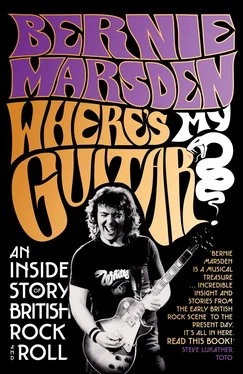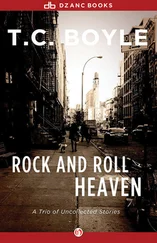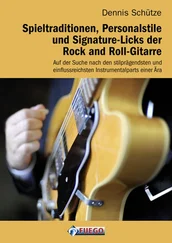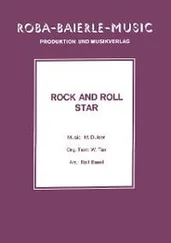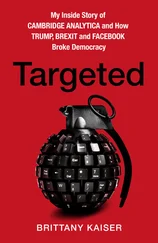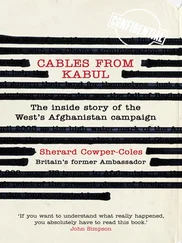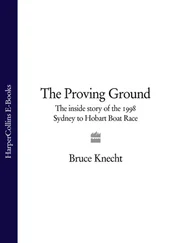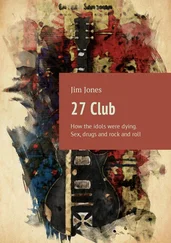1 ...6 7 8 10 11 12 ...15 It was a guitar player from Seattle, America, who provided the real reason for me deciding to leave the band. I suspect Jimi Hendrix broke up many other bands as well. I saw the unknown guitarist on Top of the Pops performing ‘Hey Joe’. I had never seen anything like him – I suppose Presley accomplished the same thing for the previous generation. Jimi did outrageous things with the guitar, such as playing with his teeth. I was mesmerised – what a sound he created. No pink sweaters on this boy.
I knew I had to form a three-piece: guitar, bass and drums. Everyone I knew was reacting to the Jimi Hendrix Experience and Cream. I was getting tired of being ‘the kid’ and I wanted to be respected as a guitarist. This was a big dream for a 16-year-old from rural Buckingham. I formed the James Watt Compassion (I have no idea why I called it that), with Paul Sandman on bass and Charlie Hill on drums. We settled on tracks by the Bluesbreakers, Cream, and Hendrix, playing them exactly the same as the records – or so we thought. As the other two were both from Bletchley and none of us had a vehicle, we rehearsed over the phone, which was not great preparation for shows. We believed we were the business, but we were just about average, and it was the material that carried us through. We lasted less than six months but I knew it wasn’t working and the others agreed. At the final show Paul’s girlfriend chinned me for encouraging him to leave his previous band. Good girl.
The audience that night also included two members of the best young group in the area, the Hydra Bronx B Band from Brackley. They were there to offer me a new job, not knowing that I was just out of a band. Ian Dysyllas and Ray Knott said I could have the use of a Marshall 50 amp and speaker. A bribe, yes, and I took it with both hands. They even had their own rehearsal room at Ian’s house in nearby Turweston, packed with amps, guitars, microphones and a drum kit. They also had a coffee machine, which was all new to me.
They were more of a soul than a blues band and they did play some great stuff: ‘Hold On I’m Coming’ and ‘Soothe Me’ by Sam and Dave, ‘Sweet Soul Music’ by Arthur Conley and the brilliant ‘Soul Finger’ by Bar-Kays. The crowds loved their Motown.
Ian ‘Dizzy’ Dysyllas played drums and Ray Knott was on organ. Then there was Tom Kemp on bass, Ian Smart and Cyril Southam on saxophones and the dynamic Chris Adams on vocals. I replaced Graham Smart as guitarist. The band wondered if fans would still come out in force with the change but we won them over from the start. Ian and Ray could hardly stop smiling after the first show. We went back to Turweston and got pretty drunk on cheap Justina wine. For the first time I was playing the music I wanted to. The discipline in the band was very good for me, and Dizzy was organised in running rehearsals and making proper musical arrangements. It highlighted my rapidly improving playing.
The band slimmed down to Ray, Dizzy, Chris and me, playing proper rhythm and blues. There were more changes. I suggested to Ray, ‘Why don’t you play bass guitar? You are so rubbish on that organ.’ Tact has never been my strong point. We drove to London the following weekend and swapped the Vox organ for a vintage Fender Precision bass. Ray still plays bass today. Now going under the name the Skinny Cat Blues Band – I was a fan of Black Cat Bones with Paul Kossoff and Simon Kirke so I think that’s were the cat came in – we set about building on the Hydra Bronx crowd. I was really enjoying myself. The Daystroms had never had a musical direction, but Skinny Cat did.
I thrived on watching other talented people play. I always tried to emulate them even if I often failed. The Skinny Cat guys picked up on this almost immediately and I gained their respect. Guitarists who were years older than me started to come to Skinny Cat gigs, while we would open for other local bands and promptly steal all their fans. That is how it was in those days.
Banbury will always hold a place in my heart, as it was the first area away from home to adopt me, as a musician, openly taking to my talent. I had gone to a new blues club there and asked to play a song during the interval, as I thought I was better than the featured band’s guitarist. Unbelievably, they agreed and the player in question, Ron Prew, even had the decency to loan me his treasured Gretsch guitar. The promoter somewhat reluctantly introduced me, I sat on a stool with this alien guitar, and played Eric Clapton’s version of the Robert Johnson song ‘Rambling on My Mind’. The audience, players and fans alike, knew the track backwards. Most only dreamed of playing the solo, but I could – note for bluesy note. For good measure I threw in a couple of extra lead breaks of my own. I was rewarded with an edgy silence and so, wincing mentally, simply said, ‘Thank you for listening.’ The place erupted with applause. A few days later Skinny Cat was booked into the venue which more usually featured pro bands such as Chicken Shack, Jellybread, Duster Bennett, and the Aynsley Dunbar Retaliation. We were in good company.
We continued to play the venue with our following increasing all the time, although Chris Adams left the band as Ray, Ian, and myself were so tight. Yours truly became the singer, but then ‘Dizzy’ left to get married. The Skinny Cat line-up of eight was now down to bassist Ray Knott and me. Mick Bullard, the drummer with another local band, was given the job. He was used to learning songs from records but we were having none of that. Ray and I wanted to jam and find our own groove, to see where it would lead us. Mick agreed to join us even though we had no money coming in and he had to leave a band whose wages contributed toward his young family. The three of us cut the name down to just Skinny Cat to avoid being pigeonholed by the ‘Blues’ and in September 1969 I went into the studio, with the group, to record for the first time.
We booked a Saturday afternoon at Shield Studio in Kettering, at something like £5 an hour. It was a lot of money for us. The engineer, Derek Tompkins, was from another era – a total boffin with sound but about as musical as a candle. Roger Taylor, later of Queen, recorded his first band’s demos there as well.
I had my much-anticipated Fender Stratocaster by then. I acquired it in 1968 through a Melody Maker ad. It was a straight swap for a Grimshaw guitar. When I met the swapper and took my guitar out of the case, a pick-up dropped out and my heart fell out with it, but luckily the guy loved the guitar and while Ray Knott shook his head in disbelief I had a 1961 three-tone sunburst Fender Stratocaster. Dreams do come true if you wait. One of the best guitar deals I ever did.
I arrived at the recording session feeling a little panicked, having been writing rather average songs for about six months. I wasn’t ever that bothered about lyrics for my songs and tended to have a solid chorus with verses made up as I went along, which was difficult in the studio. I asked the others in the band to write lyrics, but they were not remotely interested.
Feeling insecure – maybe my songs were rubbish after all – I decided to record one of our stage favourites, ‘When You Say You’re Sorry’, by American band Rhinoceros, also recorded by Rod Stewart. The B-side was a very standard twelve-bar blues, along the lines of, ‘I left my baby this morning …’ you get the picture? A very rare 45-rpm disc indeed, I still have the one and only copy! The photos from this session are better than the record.
We returned to the studio about ten months later, now driving a brand-new white Ford Transit. These later sessions produced a much better tape of four original songs, and the band was tighter and eager to record. Mr Tompkins’s input was actually invaluable. The songs were a little better and this time I actually had written out lyrics beforehand. I heard the four-track acetate again in 2016. There is a diabolical version of ‘We Can Work it Out’ by the Beatles that I had erased from my memory. Nonetheless, I remember our local fans all loved the demos.
Читать дальше
